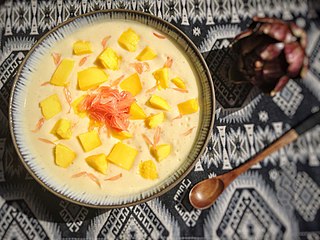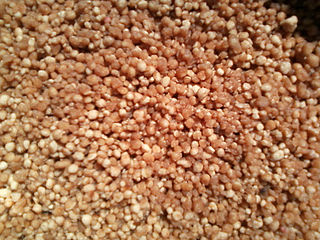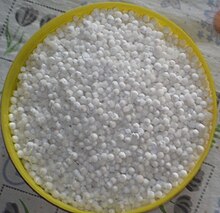
Bubble tea is a tea-based drink that originated in Taiwan in the early 1980s. Taiwanese immigrants brought it to the United States in the 1990s, initially in California through regions including Los Angeles County, but the drink has also spread to other countries where there is a large East Asian diaspora population.

Tapioca is a starch extracted from the tubers of the cassava plant, a species native to the North and Northeast regions of Brazil, but whose use is now spread throughout South America. It is a perennial shrub adapted to the hot conditions of tropical lowlands. Cassava copes better with poor soils than many other food plants.

Sago is a starch extracted from the pith, or spongy core tissue, of various tropical palm stems, especially those of Metroxylon sagu. It is a major staple food for the lowland peoples of New Guinea and the Maluku Islands, where it is called saksak, rabia and sagu. The largest supply of sago comes from Southeast Asia, particularly Indonesia and Malaysia. Large quantities of sago are sent to Europe and North America for cooking purposes. It is traditionally cooked and eaten in various forms, such as rolled into balls, mixed with boiling water to form a glue-like paste (papeda), or as a pancake.

Mochi is a Japanese rice cake made of mochigome (もち米), a short-grain japonica glutinous rice, and sometimes other ingredients such as water, sugar, and cornstarch. The steamed rice is pounded into paste and molded into the desired shape. In Japan, it is traditionally made in a ceremony called mochitsuki. While eaten year-round, mochi is a traditional food for the Japanese New Year, and is commonly sold and eaten during that time.

Chinese noodles vary widely according to the region of production, ingredients, shape or width, and manner of preparation. Noodles were invented in China, and are an essential ingredient and staple in Chinese cuisine. They are an important part of most regional cuisines within China, and other countries with sizable overseas Chinese populations.

A falooda is a Mughalai cold dessert made with vermicelli. It has origins in the Persian dish faloodeh, variants of which are found across West, Central, South and Southeast Asia. Traditionally it is made by mixing rose syrup, vermicelli, and sweet basil seeds with milk, often served with ice cream. The vermicelli used for preparing falooda is made from wheat, arrowroot, cornstarch, or sago.
Milk tea refers to several forms of beverage found in many cultures, consisting of some combination of tea and milk. The term milk tea is used for both hot and cold drinks that can be combined with various kinds of milks and a variety of spices. This is a popular way to serve tea in many countries, and is the default type of tea in many South Asian countries. Beverages vary based on the amount of each of these key ingredients, the method of preparation, and the inclusion of other ingredients Milk tea is the default type of tea in India and Pakistan and referred to as chai.

Grass jelly, also known as leaf jelly or herb jelly, is a jelly-like dessert originating from China. It is commonly consumed in East Asia and Southeast Asia. It is created by using Chinese mesona and has a mild, slightly bitter taste. Grass jelly was invented by the Hakka people who historically used the food to alleviate heat stroke after long days working in the field. The dish was introduced to Southeast Asia by the Chinese diaspora. It is served chilled, with other toppings such as fruit, or in bubble tea or other drinks. Outside Asia, it is sold in Asian supermarkets.

Kue is a Southeast Asian bite-sized snack or dessert, especially in Brunei, Indonesia, Malaysia and Singapore. Kue or kuih are fairly broad terms in the Malay archipelago to describe a wide variety of snacks including cakes, cookies, fritters, pies, scones, and patisserie. Kue are made from a variety of ingredients in various forms; some are steamed, fried or baked. They are popular snacks in the Malay archipelago, which has the largest variety of kue. Because of the archipelago's historical colonial ties, Koeé (kue) is also popular in the Netherlands.

Chè is any traditional Vietnamese sweet beverage, dessert soup or stew, or pudding. Chè includes a wide variety of distinct soups or puddings. Varieties of Chè can be made with mung beans, black-eyed peas, kidney beans, tapioca, jelly, fruit, and coconut cream. Other types are made with ingredients such as salt, aloe vera, seaweed, lotus seed, sesame seed, sugar palm seeds, taro, cassava and pandan leaf extract. Some varieties, such as chè trôi nước, may also include dumplings. Chè are often prepared with one of a number of varieties of beans, tubers, and/or glutinous rice, cooked in water and sweetened with sugar. In southern Vietnam, chè are often garnished with coconut creme.

A great variety of cassava-based dishes are consumed in the regions where cassava is cultivated, and the ingredient is included many national or ethnic specialities.

Rødgrød, rote Grütze, or rode Grütt, meaning "red groats", is a sweet fruit dish from Denmark and Northern Germany. The name of the dish in Danish features many of the elements that make Danish pronunciation difficult for non-native speakers, so, literally "red porridge with cream", has been a commonly used shibboleth since the early 1900s.

Landang is a processed starch product extracted from the inner trunk of the buli or buri tree (Corypha), a type of palm native to the Philippines and other tropical countries. This tree only flowers once in its life and then dies. Landang is visually similar to shrunken, flattened sago. It is traditionally used in making binignit in the Visayas.

Papeda, or bubur sagu, is a type of congee made from sago starch. It is a staple food of the people indigenous to Eastern Indonesia, namely parts of Sulawesi, the Maluku Islands and Papua. It is also widespread in Papua New Guinea and serves as the counterpart to central and western Indonesian cuisines that favour rice as their staple food.
Boba ice cream bars are a frozen dessert of an ice cream bar with tapioca pearls, otherwise known as boba, throughout. The ice cream is usually made from dairy products, and can be flavored with other ingredients, such as green tea or thai tea. The boba is made out of tapioca starch, becoming gelatinous when cooked.

Kue mangkok or kue mangkuk is an Indonesian kue or traditional snack of steamed cupcake. Kue mangkok means "bowl/cup cake". It is similar to the snack bolu kukus. While both have a similar appearance, bolu kukus requires few ingredients to make, whereas kue mangkok requires more than a dozen in most recipes. The result is a different texure: bolu kukus is soft and fluffy, while kue mangkok has a rough, often chewy and sticky texture.

Sarawakian cuisine is a regional cuisine of Malaysia. Like the rest of Malaysian cuisine, Sarawak food is based on staples such as rice. There is also a great variety of other ingredients and food preparations due to the influence of the state's varied geography and indigenous cultures quite distinct from the regional cuisines of the Peninsular Malaysia. Sarawak is famous for its multi-ethnic population. As the homeland of many unique communities, Sarawak has a variety of cuisines rarely found elsewhere in Malaysia. The uniqueness of Sarawak well depends on its ethnic groups. Every native group in Sarawak has their own lifestyle, traditions, cultures and also foods. Sarawak cuisine is less spicy and has a subtle in taste. It uses fresh seafood and natural herbs like turmeric, lemongrass, ginger, lime and tapioca leaves. These ingredients are not only easily available, but also add a hint of aroma, texture and freshness to the delicacies. Food is one of the most cultural identities for native groups in Sarawak with each ethnic group having their own delicacies. Among the Iban, popular foods include tubu (stems), tuak and pansuh. The Malay have bubur pedas (porridge) and kek lapis Sarawak ; the Bidayuh have asam siok and sup ponas Bidayuh. The Melanau make tebaloi, sagu and umai and the Orang Ulu are known for garam barrio, kikid (broth), tengayen, and urum giruq (pudding).

Sagu is a southern Brazilian dessert, made with tapioca pearls, sugar and red wine. It is typical of the state of Rio Grande do Sul, but also consumed in Santa Catarina and Paraná.

Kue rangi or also called sagu rangi is an Indonesian coconut kue or traditional snack made of a coconut and starch-based batter and cooked in a special molded pan. It is one of the traditional Betawi snack of Jakarta. Kue rangi often described as Indonesian coconut waffle.























